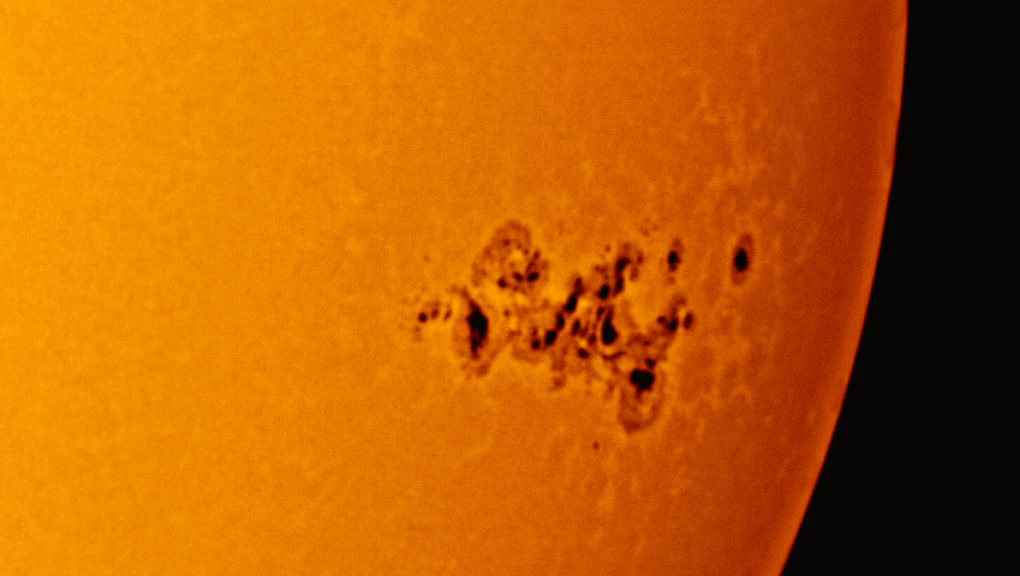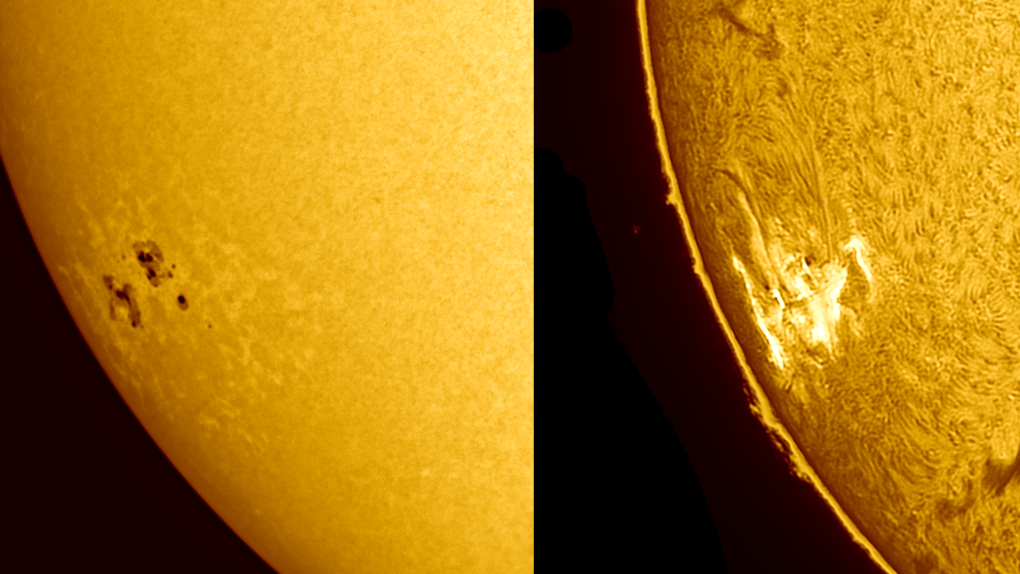Sunspot that produced aurora display in early May re-emerges
 A picture of the same area, then designated as 3664, earlier this month. The sunspot producing the solar flare that created the spectacular aurora display in early May. (Source: David Hoskin)
A picture of the same area, then designated as 3664, earlier this month. The sunspot producing the solar flare that created the spectacular aurora display in early May. (Source: David Hoskin)
A sunspot region designated as AR3697 has re-emerged from the far side of the sun. The area has generated a solar flare forecasted to bring moderate geomagnetic storm conditions Friday. That forecast comes from the Space Weather Prediction Center branch of the National Oceanographic and Atmospheric Administration.
 The active sunspot 3697 emerging from the far side of the sun. (Source: David Hoskin, Professor Emeritus Dalhousie University)
The active sunspot 3697 emerging from the far side of the sun. (Source: David Hoskin, Professor Emeritus Dalhousie University)
While not forecasted to match the severe geomagnetic storm that brought a spectacular aurora display to the Maritimes and large portions of North America early this month, it may bring some glimpses. The Space Weather Prediction Centre notes the aurora may become visible for the U.S. from New York to Idaho on Friday. That could make it a close call for the Maritimes as well.
A measurement of planetary geomagnetic activity is given as the Kp index ranging from zero to nine. A Kp index near six is forecasted and has been associated with spotting the aurora in parts of the Maritimes. Currently the timing of that peak index isn’t perfect for aurora viewing, reaching peak Friday afternoon. Should the flare impact later or the geomagnetic activity remain high enough into the night, spotting the aurora could still be possible.
 A Kp index of 6 or higher has sometimes allowed for glimpses of the aurora in the Maritimes. (Source: CTV News Atlantic)
A Kp index of 6 or higher has sometimes allowed for glimpses of the aurora in the Maritimes. (Source: CTV News Atlantic)
Northern areas of the Maritimes would be most favoured and any display of the aurora would likely be faint and low to the northern horizon. The usual night sky viewing conditions apply, such as getting away from city lights and finding as best an unobstructed view of the northern horizon as possible. There are numerous sites to monitor the geomagnetic and aurora forecasted, including the Space Weather Prediction Center: https://www.swpc.noaa.gov/ and University of Alaska: https://www.gi.alaska.edu/monitors/aurora-forecast.
Early May aurora
An interesting note about region AR3697. Before it rotated around the sun it was previously designated as AR3664. That makes it the same spot or region on the sun that produced the solar flare that led to a severe geomagnetic storm earlier this month. It was that storm that allowed the Maritimes to observe the aurora overhead.
 A picture of the same area, then designated as 3664, earlier this month. The sunspot producing the solar flare that created the spectacular aurora display in early May. (Source: David Hoskin)
A picture of the same area, then designated as 3664, earlier this month. The sunspot producing the solar flare that created the spectacular aurora display in early May. (Source: David Hoskin)
The activity forecasted for Friday into Saturday isn’t nearly as strong as that event. If the aurora does show Friday night it would most likely be fainter and closer to the northern horizon.
Night sky viewing conditions for the Maritimes Friday night are generally favourable. Patchy cloud and cool, but not expected to be overcast or rainy.
CTVNews.ca Top Stories

Pennsylvania state police commissioner reveals stunning details about Trump shooting
A local law enforcement commissioner revealed during a House Homeland Security hearing on Tuesday stunning new details about the security failures that led to the near assassination of Donald Trump, raising more questions for the embattled U.S. Secret Service.
Laws that could get Canadians in trouble in tourism hotspots
There are some laws in popular tourist destinations around the world that could land Canadian travellers in mild-to-serious trouble if they're not careful. Don't let these local laws land you in hot water during your next vacation abroad.
Polar bear at Calgary Zoo died by drowning following 'crushing' injury
The Wilder Institute/Calgary Zoo has revealed the cause of death for polar bear Baffin last week.
Clip resurfaces of Vance criticizing Harris for being 'childless,' testing Trump's new running mate
Comments Donald Trump’s running mate JD Vance made in 2021 questioning Vice President Kamala Harris’ leadership because she did not have biological children have resurfaced, testing the young conservative senator in his early days campaigning as part of the Republicans' presidential ticket.
Jasper evacuees forced into B.C. to flee fires told to make U-turn to Alberta for aid
Thousands of wildfire evacuees forced from Jasper National Park into British Columbia along smoke-choked mountain roads Monday night were directed Tuesday to make a wide U-turn and head home if they needed a place to stay.
'Stars are aligning' for Bank of Canada rate cut: economists
The Bank of Canada is expected to deliver a dose of interest rate relief Wednesday when economists and market watchers predict the central bank will cut its overnight lending rate.
Trudeau hand-picking candidate in Montreal byelection riles aspiring contenders
Prime Minister Justin Trudeau's decision to hand-pick a candidate for a riding in an upcoming Montreal byelection isn't being well-received by three aspiring contenders who spent months campaigning only to be shunted aside.
Edmonton gas station employee found guilty of terrorism charges in the U.K.
An Edmonton man has been convicted of multiple charges under the Terrorism Act in the United Kingdom.
Celine Dion lands in Paris amid reports of performance at the Olympics
Speculation is mounting that Celine Dion will make an appearance at the Paris Olympics after landing in the French capital days before the opening ceremony.


































